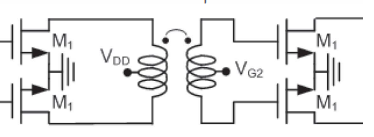Impedance matching with transformer
Could someone provide some reference/literature about how to perform impedance matching with a transformer when having a complex impedance as a load impedance? Say, I have a 20-j50 impedance that i want to match to 50 Ohms using a transformer. I could not find up to now any "detailed" literature about this, but just the typical impedance matching L networks or using transmission lines.
Any help and explanation will be very appreciated. References will be helpful too!
Greetings,
MK
A true transformer multiplies both the real and imaginary impedances, so it does not change their ratio. You have to use some reactance to vary the ratio.
Frank
Hi chuckey,
Does that apply every time? If you resonate out the reactance through one of the inductances of the transformer then you end up practically with a purely resistive load, therefore the transformer should just convert this resistance up/down depending on the arrange. The ratio would have been already changed though. Is there a way to interpret it by replacing the transformer with its T-model so at least i can follow how is the conversion performed on the smith chart?
Considering the T-model and a transformer with a 1:1 inductance ratio and a k=1, the equivalent circuit reduces basically to a parallel impedance (M = L, in this case) which would appear in parallel with the complex load but when I simulate it i don't get the same input impedance as expected. I guess there should be something wrong in my reasoning here.
Hope maybe you can provide more insight into this.
Thanks
Transformers match only the “real” part of the impedance. Transformers convert source power from one voltage and current level, to another voltage and current level, keeping (faithfully) their ratio.
You can make the imaginary part of that impedance into a resonance with a cap./ind. to eliminate this part then you may transform the resting real part onto any real one with a proper transformation ratio.
If its a well designed wideband transmission line transformer, then both real and imaginary impedances will be transformed very closely to expectations.
But a standard Faraday transformer, with inductively coupled primary and secondary, then there will very likely be extra reactive components added due to the unavoidable parasitic elements.
As mentioned in post #3, it's of course possible to match a capacitive load utilizing the shunt inductance (or the series inductance) of a transformer. It's not clear which problems you have without seeing your calculation.
A different question is if this method is a good way to tune the matching. I presume it's much easier with LC networks.
Transformers have advantages over LC networks for wide band matching with fixed (usually real) impedance ratio.
Thanks for the replies guys. For the sake of the detail, I am trying to implement an interstage matching between two amplifier stage by means of a transformer, like in the following picture

Now I guess it becomes clear what my current problem is, I have to match a capacitive input of the CS transistors to the capacitive output of the previous CS stage using the transformer. So i would start from say 20-j*20 and should end up with an input impedance at the transformer's primary of about 30 + j30 for example so the output of my 1st stage is matched. I am not sure if it is possible to "follow" this transformation with the Smith Chart if I use the T-Model of the transformer. What I′ve found up to now are the equations for the input impedance of the transformer depending on the load impedance and the coupling factor k (in Wikipedia) but I am looking for a simpler (maybe graphical) method to interpret this transformation in order to speed up the transformer design. I have to simulate it of course with an EM-simulator and then would have to iterate the design in case the achieved inductance/coupling parameters are not sufficient.
I was expecting maybe to try to choose the inductance ratio and the inductance values and then aim for a coupling depending of the transformer arrange so I can speed up the design iterations.
Hope now the picture is way more clear. Any help would be of great help.
Regards,
MK
Any transformer you build is going to have magnetizing and leakage inductance, which can be used for impedance transforming along with the impedance scaling done by the ideal transformer embedded within (google search for transformer T model). But I wouldn't expect to do an interstage match with just a transformer. You don't state your frequency or power level, so it's hard to give specific advice.
I suppose it depends if this is for single frequency operation, or broad band operation which will be much more difficult.
Impedance matching transformer 相关文章:
- Output Impedance Of a Triple cascode
- How to make image impedance equal
- Input and output impedance matching in Distributed amplifier
- Characteristic impedance of combination of CPWG and stripline on inner layers
- Problem of impedance matching of Gilbert cell mixer
- Input impedance of transmission lines connected in cascade
